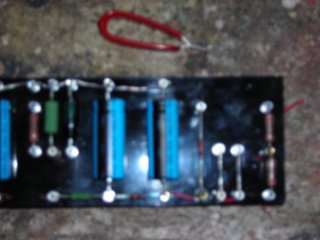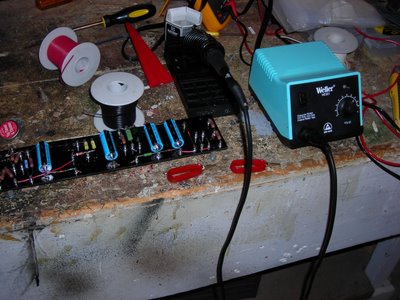 I love absolutely every stage of building this amp. I began a few months back by drilling holes and mounting turrets in this fiberglass board (called garolite). Now I finally get to load some of the electrical components like these electrolytic capacitors. If there was a stage of building that I was apprehensive about, it would probably be the debugging stage. (That's when I found out that I mounted all of these power filtering capacitors reversed!) The little red handled doohickey is used as a heat sink. When soldering capacitors and diodes, you clamp this on the leads to absorb the heat. Resistors can handle a lot of thermal abuse, so I might skip using the heat sink on that. Sometimes I use a hemastat that I have laying around, but that sort of makes me feel like a stoner.
I love absolutely every stage of building this amp. I began a few months back by drilling holes and mounting turrets in this fiberglass board (called garolite). Now I finally get to load some of the electrical components like these electrolytic capacitors. If there was a stage of building that I was apprehensive about, it would probably be the debugging stage. (That's when I found out that I mounted all of these power filtering capacitors reversed!) The little red handled doohickey is used as a heat sink. When soldering capacitors and diodes, you clamp this on the leads to absorb the heat. Resistors can handle a lot of thermal abuse, so I might skip using the heat sink on that. Sometimes I use a hemastat that I have laying around, but that sort of makes me feel like a stoner. Here is the turret board fully loaded. I could only solder about half of the turrets because some of the wires from the tone and volume controls or the tube sockets will also connect to this board. In this picture you can see my Weller soldering station. It is not the fanciest, but it is a big improvement over soldering with one of those cheap irons. In the back you can see the wire that I used for 80% of this build. It is 22 gauge solid core. It is fairly skinny stuff, and very easy to work with. The last time I used 18 gauge stranded and it got sort of messy.
Here is the turret board fully loaded. I could only solder about half of the turrets because some of the wires from the tone and volume controls or the tube sockets will also connect to this board. In this picture you can see my Weller soldering station. It is not the fanciest, but it is a big improvement over soldering with one of those cheap irons. In the back you can see the wire that I used for 80% of this build. It is 22 gauge solid core. It is fairly skinny stuff, and very easy to work with. The last time I used 18 gauge stranded and it got sort of messy.Actually, it was messy because I used eyelets, and not turrets. Also, I made the mistake of soldering everything 100% on. After putting it in the chassis, I had to desolder about 20 connections to hook up the wire. Being thicker and stranded it got messy fast. Solid core wire stays, which makes debugging hums and squeals nice. If you move it too much, it could break on the inside (almost impossible to find at first) which is why stranded has its advantages. I still used the 18-gauge stranded wire for the primary electrical connection to the power transformer, and for the heater circuit (higher current that actually makes the tubes glow). But the 22 gauge stuff was really a pleasure to work with.
--gh
No comments:
Post a Comment